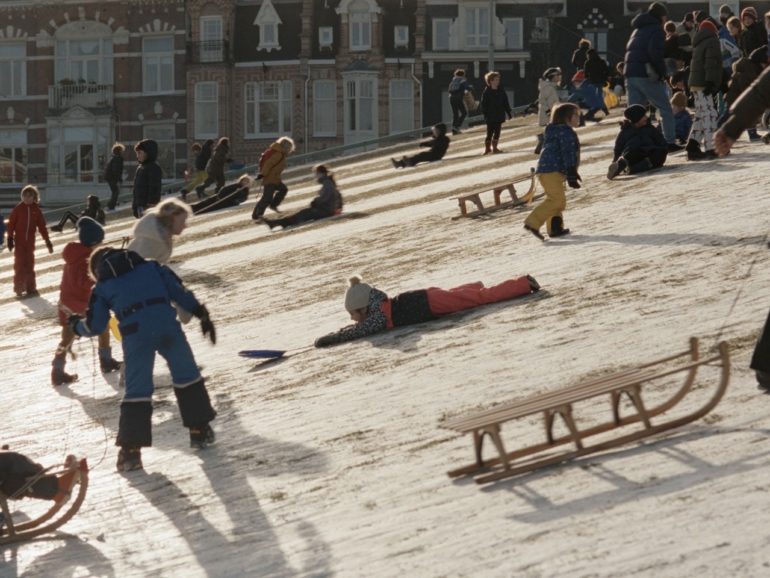They say to write what you know, the things you see out the window, your neighbourhood and the neighbours therein. Director Steve McQueen has lived in Amsterdam for almost three decades, and in making Occupied City, he asks: how much does he, or anyone else, really know about where they live? To most minds, Amsterdam is as liberal a city as can be found these days, albeit one that also tries to deal with the scars of its war-torn and deeply regressive past. Occupied City shows that the scars left all over the city by the Second World War are more numerous than we realise, and run far deeper too.
Occupied City is a film that tests the mettle of its audience in ways they wouldn’t expect. There is an austerity to its approach that will shock anyone that thinks they’ll get another standard documentary about the war. There are no talking heads interviews, nor is there any archival footage. McQueen and DoP Lennert Hillege turn their camera on various houses, buildings and locations throughout Amsterdam, while narrator Melanie Hyams delivers information on the crimes, punishments and downright atrocities committed at these sites against the Jewish citizens of the city during the war. Pre-1939, the Jewish population of Amsterdam numbered 20,000. By the end of the war, this had shrunk by 80%, and few who left ever returned, whether due to self-imposed exile, or meeting their fates at the hands of the Nazi’s brutally efficient death machine. The film opens with a resident of Amsterdam opening the door to her basement to retrieve something, while the clipped and authoritative voice of Hyams details the people who hid there after the Netherlands capitulated to the Germans in 1940. The range of stories that are recounted here is broad and terrifying. As one story ends and another one begins, the audience braces itself for what Hyams will tell us next, from the accelerated suicide rate in the city after the capitulation, to the hobbies of the arriving German guards, and many other things that beggar belief. The facts Hyams delivers come courtesy of Bianca Stigter, McQueen’s wife and a historian who catalogued the hideousnesses committed by the Nazis in her book Atlas of an Occupied City: Amsterdam 1940 – 1945. The approach McQueen takes pays dividends; in most documentaries, army movements and battles tend to overwhelm the sufferings of the general populace. The film’s point is that everyday folk (Most obviously, the Jewish population) suffered the most in Amsterdam; stories of late 1944, the ‘Hunger Winter’, are particularly soul-crushing. Worse comes still is that some suffered far more than others; the number of stories of people who informed on their Jewish neighbours, whether to save their own skin, or out of pure malice, would be maddening if it wasn’t so sad. War makes monsters of men.
McQueen emphasises the contemporary shape and sound of Amsterdam, only occasionally visiting war memorials or burial sites. The homes in which people live were once occupied by victims of the Nazis; some of them were even killed in those homes, and now we watch the current occupants live their lives in a peace the Jewish citizens of wartime Amsterdam would never be allowed. The contemporary context is emphasised not least because current events served to bring this project to fruition. In early 2020, the Netherlands and most of the rest of the world entered into a period of lockdown following the initial outbreak of Covid-19. In need of a project, but limited by where he could go and how much he could do, McQueen filmed the extraordinary shifts in life in Amsterdam from the beginning of lockdowns until after the administration of vaccines allowed life some semblance of normality. Scenes of ghoulishly empty streets, anti-lockdown protests and elderly people receiving their vaccines show Amsterdam in an extraordinary time, the likes of which it hadn’t seen since the war. It’s an effective comparison to draw, and it affords McQueen some interesting visual opportunities amidst the grim realities of the past. A scene with a tram barrelling down an empty street at night becomes a wondrous sight when the camera floats free to crane up and down the street, and Oliver Coates’ sweeps of sounds on the score drive the tram on. However, if you wanted to draw a parallel between watching prime minister Mark Rutte announcing lockdowns, and the curfews the Germans imposed on the city throughout their occupation, McQueen gives troublingly little reason to dispel such thoughts. It could be interpreted as skepticism on the director’s part. By the end, an optimism creeps back in as time passes and anti-lockdown protests segue into more useful stances like marches against climate change, but there is a discomfort at the heart of Occupied City, one that McQueen maybe works too well in invoking. As you watch children sled down mounds of snow in a park once used to round up groups of Jews for labour, the gap between past and present becomes obviously wide. So many of the buildings in which many of the crimes committed against the Jewry of Amsterdam are now demolished. Do we learn from the mistakes and horrors of the past? McQueen’s answer isn’t clear, but then it’s unlikely anyone else’s is either.
Occupied City is intended as a miniseries, which can only be a good thing. At 262 minutes, including an intermission, it necessarily tries the patience, especially when there is little-to-no change in its structure or methods as it goes along. Still, it has a raw power in the events it describes and the city it presents. When you see a group of dark-skinned young men dancing and rapping outside a building that once housed the business of a militant Nazi volunteer, you can’t help but feel some hope. McQueen’s very presence in Amsterdam is a rebuke of what came before, and Occupied City ultimately does hope that the city will continue to be a beacon of greater acceptance.

